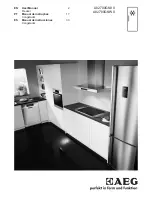
The equipment has to be cleaned
regularly:
1.
Clean the inside and accessories with
lukewarm water and some neutral
soap.
2.
Regularly check the door seals and
wipe clean to ensure they are clean
and free from debris.
3.
Rinse and dry thoroughly.
4.
If accessible, clean the condenser
and the compressor at the back of
the appliance with a brush.
This operation will improve the
performance of the appliance and
save electricity consumption.
7.4
Defrosting the freezer
The freezer compartment is frost free.
This means that there is no build up of
frost when it is in operation, neither on
the internal walls nor on the foods.
The absence of frost is due to the
continuous circulation of cold air inside
the compartment, driven by an
automatically controlled fan.
7.5
Periods of non-operation
When the appliance is not in use for long
periods, take the following precautions:
1.
Disconnect the appliance from
electricity supply.
2.
Remove all food.
3.
Clean the appliance and all
accessories.
4.
Leave the door/doors open to
prevent unpleasant smells.
WARNING!
If the cabinet will be kept on,
ask somebody to check it
once in a while to prevent
the food inside from spoiling
in case of a power failure.
8.
TROUBLESHOOTING
WARNING!
Refer to Safety chapters.
8.1
What to do if...
Problem
Possible cause
Solution
The appliance does not op-
erate.
The appliance is switched
off.
Switch on the appliance.
The mains plug is not con-
nected to the mains socket
correctly.
Connect the mains plug to the
mains socket correctly.
There is no voltage in the
mains socket.
Connect a different electrical
appliance to the mains socket.
Contact a qualified electrician.
The appliance is noisy.
The appliance is not sup-
ported properly.
Check if the appliance stands
stable.
Audible or visual alarm is on. The cabinet has been re-
cently switched on or the
temperature is still too
high.
Refer to "Door Open Alarm"or
"High Temperature Alarm".
www.aeg.com
12













































